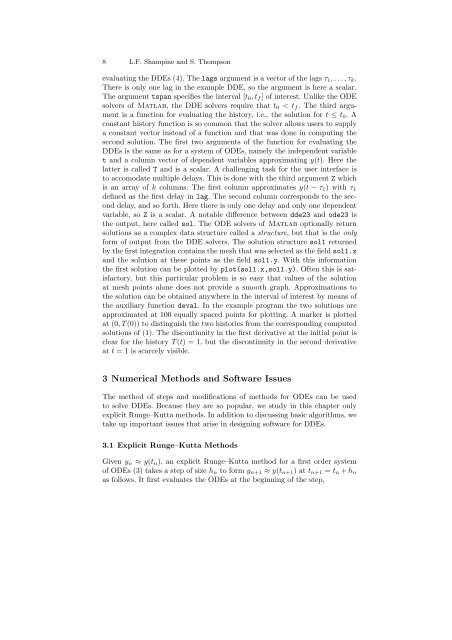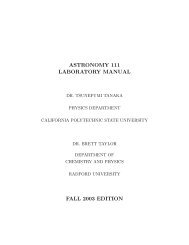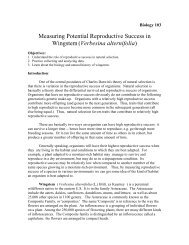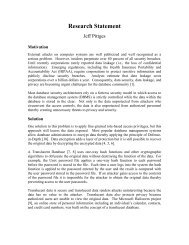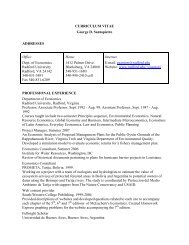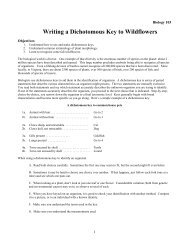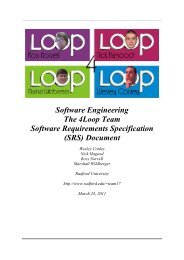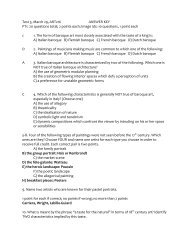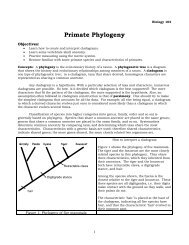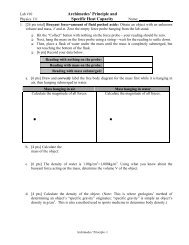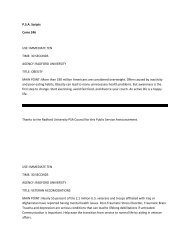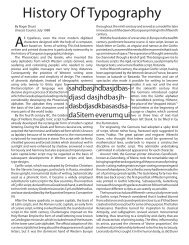Solving Delay Differential Equations - Radford University
Solving Delay Differential Equations - Radford University
Solving Delay Differential Equations - Radford University
You also want an ePaper? Increase the reach of your titles
YUMPU automatically turns print PDFs into web optimized ePapers that Google loves.
8 L.F. Shampine and S. Thompson<br />
evaluating the DDEs (4). The lags argument is a vector of the lags τ1, . . . , τk.<br />
There is only one lag in the example DDE, so the argument is here a scalar.<br />
The argument tspan specifies the interval [t0, tf ] of interest. Unlike the ODE<br />
solvers of Matlab, the DDE solvers require that t0 < tf . The third argument<br />
is a function for evaluating the history, i.e., the solution for t ≤ t0. A<br />
constant history function is so common that the solver allows users to supply<br />
a constant vector instead of a function and that was done in computing the<br />
second solution. The first two arguments of the function for evaluating the<br />
DDEs is the same as for a system of ODEs, namely the independent variable<br />
t and a column vector of dependent variables approximating y(t). Here the<br />
latter is called T and is a scalar. A challenging task for the user interface is<br />
to accomodate multiple delays. This is done with the third argument Z which<br />
is an array of k columns. The first column approximates y(t − τ1) with τ1<br />
defined as the first delay in lag. The second column corresponds to the second<br />
delay, and so forth. Here there is only one delay and only one dependent<br />
variable, so Z is a scalar. A notable difference between dde23 and ode23 is<br />
the output, here called sol. The ODE solvers of Matlab optionally return<br />
solutions as a complex data structure called a structure, but that is the only<br />
form of output from the DDE solvers. The solution structure sol1 returned<br />
by the first integration contains the mesh that was selected as the field sol1.x<br />
and the solution at these points as the field sol1.y. With this information<br />
the first solution can be plotted by plot(sol1.x,sol1.y). Often this is satisfactory,<br />
but this particular problem is so easy that values of the solution<br />
at mesh points alone does not provide a smooth graph. Approximations to<br />
the solution can be obtained anywhere in the interval of interest by means of<br />
the auxiliary function deval. In the example program the two solutions are<br />
approximated at 100 equally spaced points for plotting. A marker is plotted<br />
at (0, T (0)) to distinguish the two histories from the corresponding computed<br />
solutions of (1). The discontinuity in the first derivative at the initial point is<br />
clear for the history T (t) = 1, but the discontinuity in the second derivative<br />
at t = 1 is scarcely visible.<br />
3 Numerical Methods and Software Issues<br />
The method of steps and modifications of methods for ODEs can be used<br />
to solve DDEs. Because they are so popular, we study in this chapter only<br />
explicit Runge–Kutta methods. In addition to discussing basic algorithms, we<br />
take up important issues that arise in designing software for DDEs.<br />
3.1 Explicit Runge–Kutta Methods<br />
Given yn ≈ y(tn), an explicit Runge–Kutta method for a first order system<br />
of ODEs (3) takes a step of size hn to form yn+1 ≈ y(tn+1) at tn+1 = tn + hn<br />
as follows. It first evaluates the ODEs at the beginning of the step,


